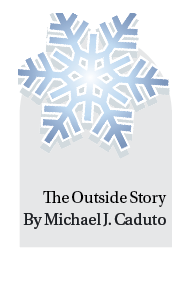
In mid-winter 1988, I went contra-dancing at the Congregational Church in Lyme, New Hampshire. During intermission, I joined other dancers who stepped out of the overheated hall into a star-studded night alive with shimmering waves of color, from blue to pinkish-red. We stood in awe, while luminous curtains of light performed a pas-de-deux across the arch of the sky dome.
Our home star was the director of this celestial dance, and atmospheric gases choreographed the show. Northern lights, the aurora borealis – perhaps the most spectacular display of winter light – are borne of light emitted when electrons in the gases of Earth’s upper atmosphere (nitrogen and oxygen) are energized by bursts from a solar geomagnetic storm. The northern lights are one of many forms of radiance that color our lives throughout the shortest days, influenced by the angle of the sun and moon, as well as other factors.
“The sun angle certainly affects the quality of the light” during winter, said Mark Breen, senior meteorologist and planetarium director at the Fairbanks Museum and Planetarium in St. Johnsbury, Vermont. “When the sun tracks low across the skies, it has to travel a longer path through the atmosphere, filtering the brighter blues and greens, and allowing a greater mix of the reds, yellows, and oranges that favor a golden hint to the light.”
That affects the brilliance of sunrises and sunsets, which often seem more colorful during winter days. In addition, a study conducted at the University of York revealed that human perception of color in the range of yellow actually shifts with the seasons due to changes we see in the natural world. During the summer, our eyes are exposed to an abundance of green leaves, but winter months are dominated by grays and browns. In response, our summer color perception is more sensitive to greenish yellows, while in winter it highlights reddish yellows.
The sun’s angle also means that sunbows – which resemble a rainbow around the sun – are more common during cold winter mornings and evenings. As the sun arches low, high altitude ice crystals become tiny prisms that refract sunlight into an aura around the sun. Snow and ice also provide color and sparkle during winter. Minute ice-crystal spectrums can be seen when viewing the brightly lit surface of powdery snow through polarized sunglasses, fragmenting each snow-star’s sunlight as tiny prisms bejewel the land with violet starbursts.
Emily Dickinson elegantly expressed the way winter light transforms the nivean world in her poem “A Certain Slant of Light”: “When it comes, the Landscape listens–/Shadows–hold their breath –.”
“Once the sun sets, a clear moonless sky is SO dark. Should the skies clear, the ebony velvet of night is pierced with the diamond light of the distant stars,” said Breen, noting that the angle of the moon and its reflection onto snow also contribute to differences in winter light. “A winter’s full moon bathes the snow-encrusted landscape with a surprising brilliance. Positioned as high, or even a little higher than the summer solstice sun, its silver light, though bright, almost seems imbued with the deep, penetrating cold of a clear, calm winter’s night.”
Stillness reigns. Time stands still. Winter light enthralls with a face both ineffable and infinite.
The best way to experience winter light is to “sally forth,” as Thoreau might say, as in his literary saunterings of “A Winter Walk”: “At length we awake to the still reality of a winter morning. The snow lies warm as cotton or down upon the window-sill; the broadened sash and frosted panes admit a dim and private light.”
Breen encourages people to experience the changes of winter light. “Take the time, even 15 minutes, and simply observe and enjoy the ‘little beauties’ – how the sun shines on an icicle, how the alpenglow (the pink-amber color of the sunlight from the setting sun) gives the mountains an almost surrealist painting appearance. Bundle up and find a dark location to let yourself almost ‘fall’ into the stars that surround you. And maybe, just maybe through the immersion, realize that every one of us can find some beauty, and some peace.”
Perchance winter light touches us deeply because it reflects, in the grand tapestry of sky, the existential duality of darkness and light with which we all struggle. Or maybe winter light is so enchanting simply because it is extraordinarily beautiful.
Michael J. Caduto is a writer, ecologist, and storyteller who lives in Reading, Vermont. He is coauthor of “Keepers of the Night: Native American Stories and Nocturnal Activities for Children.” Illustration by Adelaide Murphy Tyrol. The Outside Story is assigned and edited by Northern Woodlands magazine and sponsored by the Wellborn Ecology Fund of the New Hampshire Charitable Foundation: nhcf.org.



